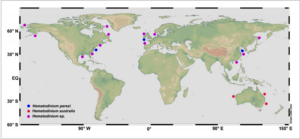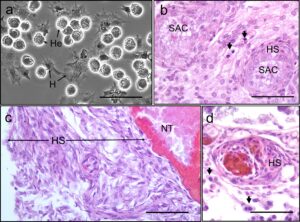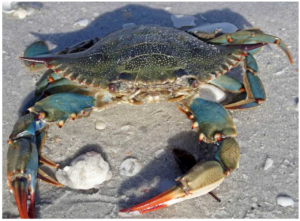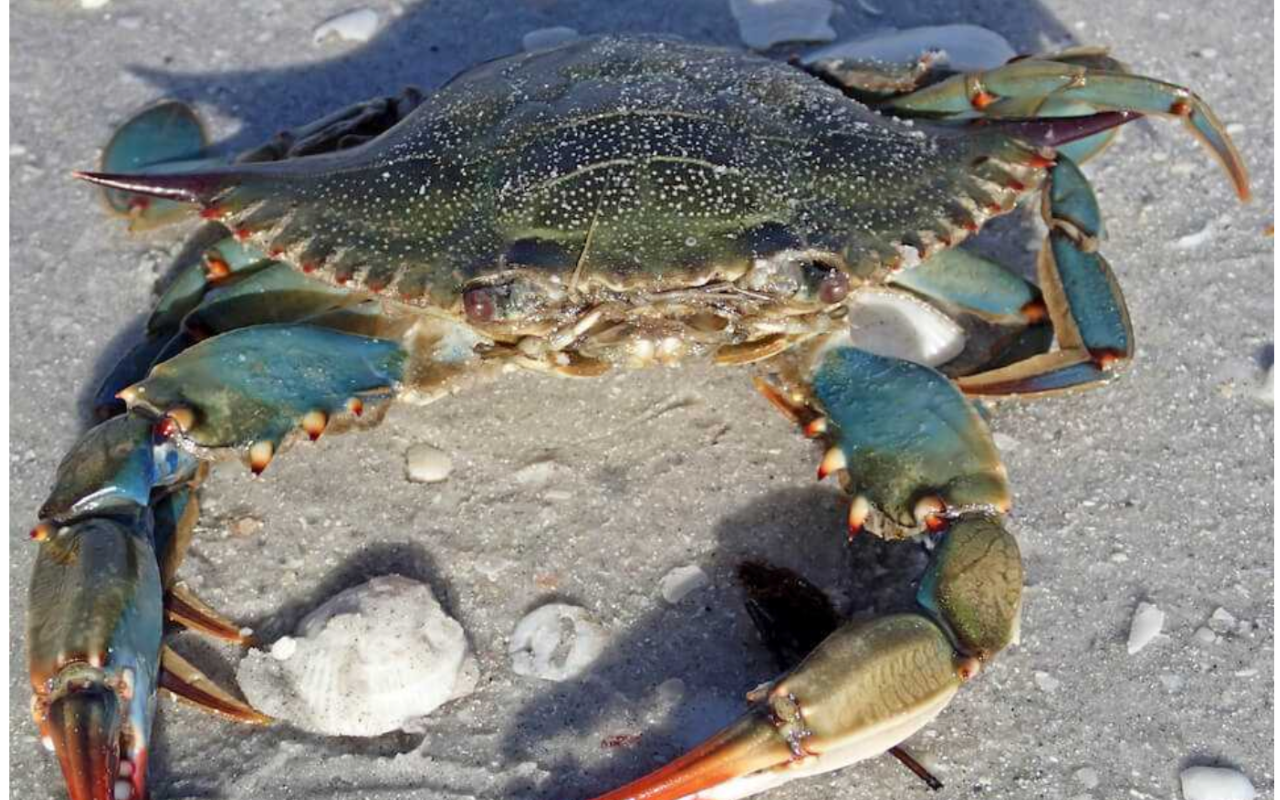Stentiford GD, Shields JD. A review of the parasitic dinoflagellates Hematodinium species and Hematodinium-like infections in marine crustaceans. Dis Aquat Organ. 2005 Aug 9;66(1):47-70. doi: 10.3354/dao066047.
*********
A Conundrum of Global Marine Crustacean Diseases: Bitter Crab Disease
Bitter Crab Disease / Syndrome (BCD or BCS) is a fatal disease facing crustaceans, and is caused by a parasitic dinoflagellate (a single-celled organism) from the genus Hematodinium. To this day, nearly 30 species of crustaceans, globally, are known to be infected by Hematodinium spp., with the majority of parasitized hosts (the organism(s) that harbors the parasite) in the Atlantic Oceans and the North Pacific [Fig. 1]. Importantly, affected species include many commercially-vital species such as the blue crab (eastern US and Gulf of Mexico), the Tanner crab (Southeast Alaska), the snow crab (Bering Sea, Canada, and Greenland), the Norway lobster (Baltic Sea), and the velvet crabs (North Atlantic Ocean). Data tell us that while the infections may be more common in commercial marine species, the disease is more frequent in juvenile species and pre-recruits (younger life stages of species, such as juveniles).

Figure 1. Image Source: AAAS 2021. The global distribution and diversity of the parasitic dinoflagellate Hematodinium.
Dinoflagellates of Hematodinium include at least three parasitic species, H. perezi, H. australis, and Hematodinium sp., which target many crustacean hosts, as far south as Australia and as far north as Greenland.
All of this said, however, the impact of Hematodinium-associated diseases on commercial crustacean populations remains understudied. Epizootics of Hematodinium spp. can devastate localized communities, fishery and aquaculture industries with langoustines, shrimp, and blue crabs representing some of the more than 40 known susceptible marine parasites. Importantly, other non-commercial crustacean species that are affected by Hematodinium spp. are also ecologically important in benthic (lowest level of a body of water) and intertidal (area of ocean that experiences both low and high tides) ecosystems.
The type species (the species on which the genus description was based) of this parasitic dinoflagellate was first described in France in 1931. In 1975, a similar parasitic dinoflagellate was discovered in the blue crab, in estuaries of North Carolina, Florida, and Georgia. Then, in 1987, Hematodinium spp. was reported in Southeast Alaska in Tanner crabs, and this was significant because it was the first case where prevalence (the proportion of the host population with the disease) of the disease approached 100 percent, which indicated that this disease could actually wipe out entire populations of crabs. During this disease encounter, in fact, it was estimated that approximately 200,000 pounds of live Tanner crabs were deemed “unfit for human consumption” due to a notable bitter aftertaste (and hence the name, Bitter Crab Disease).
The life history (an organism’s lifetime patterns of survival and reproduction) of Hematodinium is minimally understood. It was only described for one given point in the infection stage [Fig. 2], so the phases of infection before or after this point, or until other hosts become infected remains to be discovered. Therefore, the method of infection, the number of free-living stages, the morphology (the parasite’s physical structure).

Figure 2. Image Source: eLife 2022. Interaction between Hematodinium and cellular defenses of the shore crab, Carcinus maenas.
The Alaska Fisheries Science Center’s Fisheries Resources Pathobiology program has been monitoring BCS in both snow crabs and Tanner crabs, in the eastern Bering Sea, since 1988. Disease monitoring was initially dependent upon microscopic analysis of blood smears, but now there are more modern methods such as polymerase chain reaction (PCR) – a technique used to amplify certain segments of DNA.
Despite the many unknowns surrounding our understanding of Hematodinium, it is evident that the potential impacts of this disease complex on crustacean species, commercial and non-commercial alike, should not be ignored. Marine diseases are generally present at some level in open waters, but epizootics and epidemics are disease outbreaks that far exceed the expected or measured background disease levels and can have dire, and sometimes unrecoverable impacts on host species. Some examples of such cases are the Spanish flu epidemic in 1918, ciliate disease in Dungeness crabs (1990-1992), and phocine distemper virus of harbor seals (1988, 1998, 2000, 2002). Epizootics and epidemics occur over many years or decades, and as is the connotation of their name, they are not common. However, the continued presence of many diseases, human and environmental, terrestrial and marine alike, continue to sustain.

Figure 3. Image Source: Climate Adaptation Explorer 2022. A blue crab (Callinectes sapidus).
Furthermore, in recent years, concern over climate change has now brought another challenge to light: whether climate change might be playing a role in emerging infectious diseases (infectious diseases that have newly appeared in a population or have existed but are rapidly increasing in incidence or geographic range). Many studies have begun to show evidence that warming temperatures may affect terrestrial and marine health globally, such as studies on coral reef health and amphibian disease outbreaks. Hematodinium-associated diseases appear to, in fact, have become more prevalent in the North Pacific over the last 22 years, which has also corresponded with a recognized regime shift in global climate. The possible relationship between climate and Hematodinium-associated diseases, therefore, seems to warrant further discovery.
Krti is interested in the transmission dynamics of environmental diseases as they relate to climate and anthropogenic stressors. As a Fulbright Scholar, Krti conducted analyses on the responses of dengue fever to climatic stressors off the coast of the Bay of Bengal, in India. Currently, Krti works with Stanford University to understand the role of schistosomiasis in environmental reservoirs, and leads the pursuit of a computational-based based analysis of eelgrass wasting disease dynamics. At Stanford, Krti serves as one of the few trans-disciplinary experts for planetary health topics, via machine learning and computer vision, data science, environmental policy, and science communication. As a STEM innovator and a first-generation woman of color, Krti is proud to be a writer for Oceanbites!


